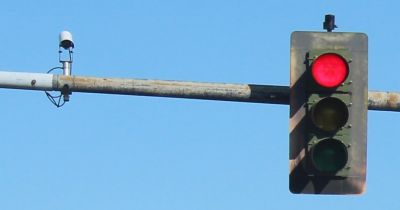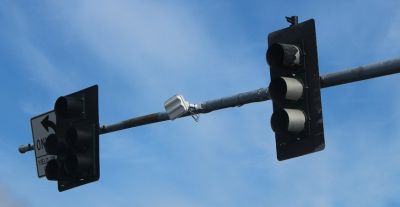
The department regularly receives inquiries about the cameras sitting atop traffic signals. Residents often ask what the cameras are for, what they record and what information is saved on them. Here, we’ll break down what the traffic cameras do and explain a newer technology you might notice on some signals.
Traffic cameras
 These cameras simply detect the arrival of vehicles at an intersection and relay that to the signal control system for that intersection.
These cameras simply detect the arrival of vehicles at an intersection and relay that to the signal control system for that intersection.
These cameras don’t do the following things:
- Record video;
- Read vehicle license plates;
- Zoom in on specific vehicles. These cameras are in a fixed focus and a fixed location. They don’t move around; or
- Send information to law enforcement. These cameras are not red-light running cameras.
Before the traffic cameras, the state used in-ground detection loops. The in-ground detection systems were prone to break in extreme cold weather and costly to repair. They were less reliable for detection, as they could only detect vehicles that were fully in lanes. This led to less reliable detection during winter when snow obscures lane divisions.
Video detection is not without flaws, though, and is prone to experiencing problems when there is sun glare on ice or snow covered roadways. When this happens, the signal may change to give a green light to an intersection leg with no vehicles. This is referred to as a false call. The cameras can also have difficulty detecting vehicles during periods of heavy fog.
Radar detectors
 During the past two summers, several of our intersections have been converted to newer radar detection technology (little white boxes on the signal
mast arms) to reduce the number of false calls and improve detection during ice fog events. As more signals are upgraded through projects, our
plan is to switch more of them to radar.
During the past two summers, several of our intersections have been converted to newer radar detection technology (little white boxes on the signal
mast arms) to reduce the number of false calls and improve detection during ice fog events. As more signals are upgraded through projects, our
plan is to switch more of them to radar.
Radar detectors work similarly to cameras. A detection zone is set up and a baseline “image” of the intersection is established (by knowing how far it is to various fixed objects). The unit transmits radar beams that will “see” something enter the detection zone, meaning the distance to the object the unit is expecting to find is interrupted by the presence of a vehicle.
Previous Blogs
- Mailboxes and Snow
- Road Priorities for
Snow Removal - Reflectors
- Construction Manager/
General Contractor - Safe Biking
- Bicycles on the Road
- Update: Johansen Expressway
- Online Open House
- Wood Retrieval
- Iditarod Restart
- Parks Highway 2015 Projects
- Super Open House 2015
- Damalanche
- Speed Limits
- REDDI
- Winter Pedestrian Safety
- Driveway Snow Removal
- Safe Winter Driving
- Public Involvement Calendar
- Public Involvement
- Salt Brine 101
- Traffic Counters
- Traffic Detection
- Welcome Blog
